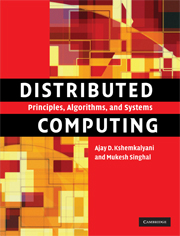Book contents
- Frontmatter
- Contents
- Preface
- 1 Introduction
- 2 A model of distributed computations
- 3 Logical time
- 4 Global state and snapshot recording algorithms
- 5 Terminology and basic algorithms
- 6 Message ordering and group communication
- 7 Termination detection
- 8 Reasoning with knowledge
- 9 Distributed mutual exclusion algorithms
- 10 Deadlock detection in distributed systems
- 11 Global predicate detection
- 12 Distributed shared memory
- 13 Checkpointing and rollback recovery
- 14 Consensus and agreement algorithms
- 15 Failure detectors
- 16 Authentication in distributed systems
- 17 Self-stabilization
- 18 Peer-to-peer computing and overlay graphs
- Index
1 - Introduction
Published online by Cambridge University Press: 05 June 2012
- Frontmatter
- Contents
- Preface
- 1 Introduction
- 2 A model of distributed computations
- 3 Logical time
- 4 Global state and snapshot recording algorithms
- 5 Terminology and basic algorithms
- 6 Message ordering and group communication
- 7 Termination detection
- 8 Reasoning with knowledge
- 9 Distributed mutual exclusion algorithms
- 10 Deadlock detection in distributed systems
- 11 Global predicate detection
- 12 Distributed shared memory
- 13 Checkpointing and rollback recovery
- 14 Consensus and agreement algorithms
- 15 Failure detectors
- 16 Authentication in distributed systems
- 17 Self-stabilization
- 18 Peer-to-peer computing and overlay graphs
- Index
Summary
Definition
A distributed system is a collection of independent entities that cooperate to solve a problem that cannot be individually solved. Distributed systems have been in existence since the start of the universe. From a school of fish to a flock of birds and entire ecosystems of microorganisms, there is communication among mobile intelligent agents in nature. With the widespread proliferation of the Internet and the emerging global village, the notion of distributed computing systems as a useful and widely deployed tool is becoming a reality. For computing systems, a distributed system has been characterized in one of several ways:
You know you are using one when the crash of a computer you have never heard of prevents you from doing work.
A collection of computers that do not share common memory or a common physical clock, that communicate by a messages passing over a communication network, and where each computer has its own memory and runs its own operating system. Typically the computers are semi-autonomous and are loosely coupled while they cooperate to address a problem collectively.
A collection of independent computers that appears to the users of the system as a single coherent computer.
A term that describes a wide range of computers, from weakly coupled systems such as wide-area networks, to strongly coupled systems such as local area networks, to very strongly coupled systems such as multiprocessor systems.
- Type
- Chapter
- Information
- Distributed ComputingPrinciples, Algorithms, and Systems, pp. 1 - 38Publisher: Cambridge University PressPrint publication year: 2008



